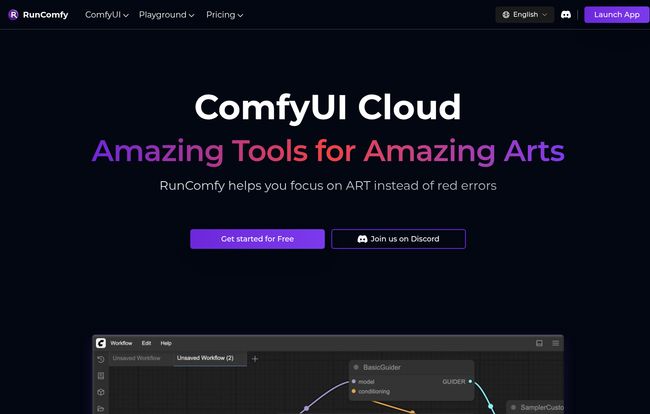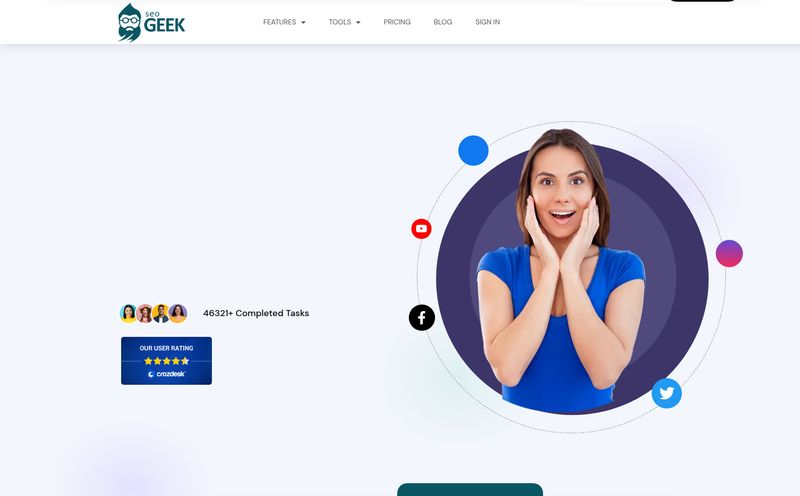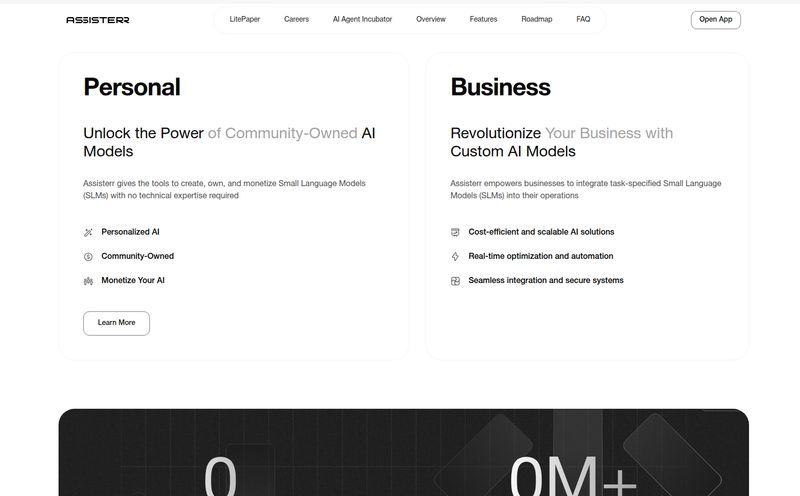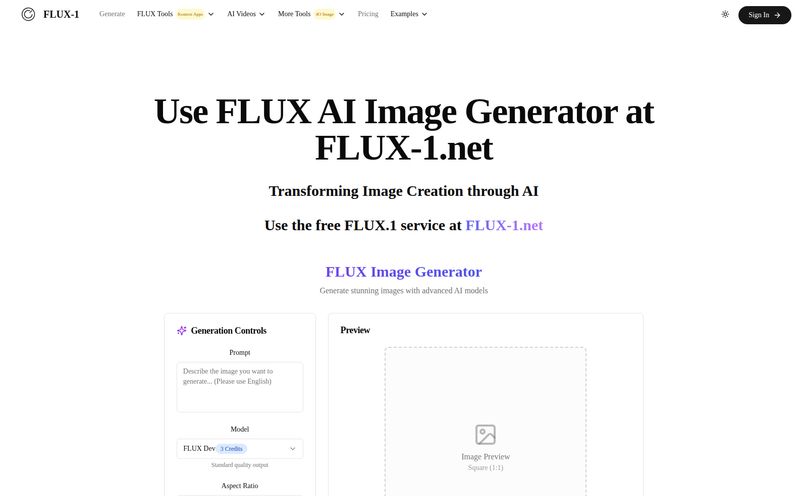Let’s have a little chat. You and me. If you’ve spent any time in the AI art space, you've heard of ComfyUI. It's the powerhouse, the mad scientist's laboratory, the node-based behemoth for Stable Diffusion that gives you unparalleled control over your creations. You see those incredible, multi-step AI animations or impossibly consistent characters online? Yeah, a lot of that magic is brewed in a ComfyUI workflow.
But here’s the other side of that coin, the one we don’t always post about on X (formerly Twitter). The setup. Oh, the setup. The endless command-line windows, the Python version conflicts, the cryptic “red error” boxes that pop up and mock your feeble attempts at creativity. And don't even get me started on VRAM. It's like a constant, thirsty monster that's never satisfied. I’ve been there, pulling my hair out at 2 AM, wondering if I should have just stuck to MS Paint.
So when I stumbled upon a platform called RunComfy, my interest was piqued. The tagline on their site—“RunComfy helps you focus on Art instead of red errors”—spoke to me on a spiritual level. A cloud-based ComfyUI that just… works? No setup? Access to beefy GPUs? It sounded a little too good to be true. So, naturally, I had to take it for a spin.
First Off, What Is ComfyUI for the Uninitiated?
Before we go further, let's get on the same page. If you're new here, ComfyUI is a graphical user interface for Stable Diffusion. Instead of simple text prompts and sliders, you connect different blocks (or “nodes”) together to build a visual flowchart. One node loads a model, another writes a prompt, a third one samples the image, and so on. It’s incredibly powerful, allowing for complex chains of logic that other UIs can only dream of. The downside? It has a learning curve like a vertical cliff and running it locally requires a decent gaming PC, patience, and a bit of technical know-how.
So, What is RunComfy and How Does It Change the Game?
Alright, back to the star of the show. RunComfy is essentially ComfyUI as a service. It gives you that entire, powerful, node-based experience, but it runs on their high-performance servers in the cloud. You access it through your web browser. That’s it. No installing Python, no fighting with Git, no downloading massive model files that clog up your hard drive.
Think of it like this: instead of building your own professional kitchen from scratch—buying the oven, installing the gas lines, getting all the permits—you get to rent time in a fully-equipped, Michelin-star kitchen. You just show up with your ingredients (your ideas) and start cooking. It’s the native, unadulterated ComfyUI experience, just without the initial nightmare.

Visit RunComfy
The Features That Made Me Sit Up and Pay Attention
I’m a skeptical guy. I've seen a lot of platforms promise the world and deliver a barren asteroid. But as I poked around RunComfy, a few things genuinely impressed me. This isn't just about avoiding a tricky install; it's about building a smarter workflow.
Literally Zero-Fuss Setup
This is the headline feature, and they nail it. You sign up, you click a button to launch a machine, and a familiar ComfyUI interface appears in your browser. It’s ready to go. For anyone who has ever spent an afternoon in a forum trying to debug a `CUDA` error, this feature alone is worth its weight in gold.
A Library of Models and Nodes Without the Wait
One of the biggest drags of local ComfyUI is managing models and custom nodes. Downloading a 7GB checkpoint model from Civitai can take forever on my home internet. RunComfy has this brilliant feature where you just paste a link from Civitai or Hugging Face, and it downloads the model to your cloud machine at lightning speed. We’re talking seconds, not minutes. The same goes for custom nodes. The integrated ComfyUI-Manager lets you install any node you need with a couple of clicks. It's so smooth, it almost feels like cheating.
GPU Power on Demand (Without a Second Mortgage)
My local rig has a decent GPU, but it chokes on larger models or high-res upscaling. RunComfy offers a buffet of GPU options, from a respectable 16GB of VRAM all the way up to a monstrous 80GB A100. Being able to just spin up a machine with more power for a specific, demanding task is a massive advantage. You pay for what you use, so you're not shelling out thousands for a new graphics card you might only need once in a while.
Workflows You Can Actually Save and Share
Ever create a masterpiece workflow and then accidentally close it without saving the API file? Pain. RunComfy automatically saves your environment. You can shut down your machine, come back the next day, and pick up right where you left off. Even better, you can generate a shareable link that contains your entire setup—the workflow, the models, the custom nodes. This is incredible for collaboration or for creating tutorials. No more “here’s a screenshot of my nodes, good luck recreating it” nonsense.
Let's Talk Turkey: The RunComfy Pricing Structure
Okay, this is where a lot of cloud services get you. The pricing can be confusing or outrageously expensive. RunComfy’s model is actually pretty straightforward, and I appreciate the transparency. They have two main tiers.
| Plan | Cost | Key Features |
|---|---|---|
| Hobby | Free | - 20 hrs/month CPU time - 1 hr/month GPU time - 10GB private storage - Files deleted after 72 hrs inactivity |
| Pro | $19.99/month (or $10/mo if billed annually) | - Everything in Hobby, plus: - Persistent Storage (files are permanent) - 250GB private storage - 200+ popular models preloaded - Priority support |
The Free "Hobby" Plan is No Joke
I was genuinely surprised by how generous the free plan is. You get an hour of GPU time per month, which is enough to get your feet wet, test some workflows, and decide if the platform is for you. The big catch is that your files and storage get wiped after 72 hours of inactivity. It's a trial plan, not a permanent home for your work. But for trying things out? It’s perfect. And no credit card required to start is a huge plus.
The "Pro" Plan for the Committed Creator
If you get serious, the Pro plan is where it's at. The single most important feature here is persistent storage. This means your files, models, and outputs stick around. At $10-20 a month, it's a reasonable price for the convenience and peace of mind, especially when you factor in the massive 250GB of storage and preloaded models that save you even more time.
It's important to remember that for both plans, the GPU time beyond the free credits is pay-as-you-go. A Medium Machine (16GB GPU) costs about $0.79/hour, while the big guns get more expensive. This is a fair model that lets you scale your costs with your usage.
But Who Is This Really For?
After playing with it for a while, I have a pretty clear idea of who would get the most out of RunComfy.
- The Curious Beginner: If you've been scared off by ComfyUI's reputation, this is your easy entry point. The free tier is a no-risk way to learn the most powerful AI art tool out there.
- The Mac User: Let's be honest, the AI art world can be hostile to Apple users. RunComfy completely levels the playing field, giving Mac users access to the same powerful tools without needing a specific type of computer.
- The Under-Powered PC Owner: Still rocking an old GTX 10-series card? You can still create state-of-the-art imagery by offloading the heavy lifting to the cloud.
- The Busy Professional: For artists, designers, and creators who just need a tool that works, RunComfy removes the IT admin part of the job. Your time is better spent creating, not debugging.
The Trade-Offs: No Such Thing as a Free Lunch
It’s not all sunshine and rainbows. There are inherent trade-offs with any cloud service. You're reliant on an internet connection, for one. If your Wi-Fi goes down, so does your workflow. You're also placing your trust in a third-party company, and while heavy usage can be cost-effective compared to buying a new GPU, the costs can add up if you leave a machine running 24/7. But for me, these are minor quibbles compared to the headaches it solves.
My Final Verdict on RunComfy
I came in skeptical, but I’m walking away a convert. RunComfy isn’t trying to replace the local ComfyUI experience for hardcore tinkerers who love being in the weeds. Instead, it’s democratizing it. It’s making one of the most powerful creative AI tools accessible to everyone, regardless of their technical skill or the hardware sitting on their desk.
It successfully abstracts away the most frustrating parts of the process, leaving you with the fun part: the art. If you've ever been on the fence about trying ComfyUI, or if you're just tired of the local setup battle, I genuinely think you should give RunComfy a shot. The free Hobby plan makes it a complete no-brainer.
Frequently Asked Questions
- Can I upload my own models and LoRAs to RunComfy?
- Yes, absolutely. You can upload your own models, LoRAs, and other files directly to your private storage drive on the platform.
- Is it the real ComfyUI or a simplified version?
- It's the real, native ComfyUI experience. You have the full interface and can install any custom nodes you need, just like a local installation. You aren't missing out on any features.
- What happens to my generated images? Are they private?
- The images you generate are saved to your private cloud drive. They are your property and are not shared publicly unless you choose to share them.
- What if I'm a total beginner? Are there tutorials?
- RunComfy provides over 100 pre-built workflows for various tasks like image editing, video creation, and more. These are fantastic starting points for learning how different nodes work together.
- Will my models be saved if I'm on the free plan?
- On the free Hobby plan, your entire session, including any downloaded models or generated images, will be deleted after 72 hours of inactivity. For permanent storage, you'll need the Pro plan.
- How does the hourly billing work?
- You are only billed for the time your machine (the CPU or GPU you're using) is actually running. When you stop the machine, the billing stops. You can start and stop it as needed.
Reference and Sources
- RunComfy Official Website
- Civitai - Home of Stable Diffusion Models
- Hugging Face - The AI Community Building the Future



